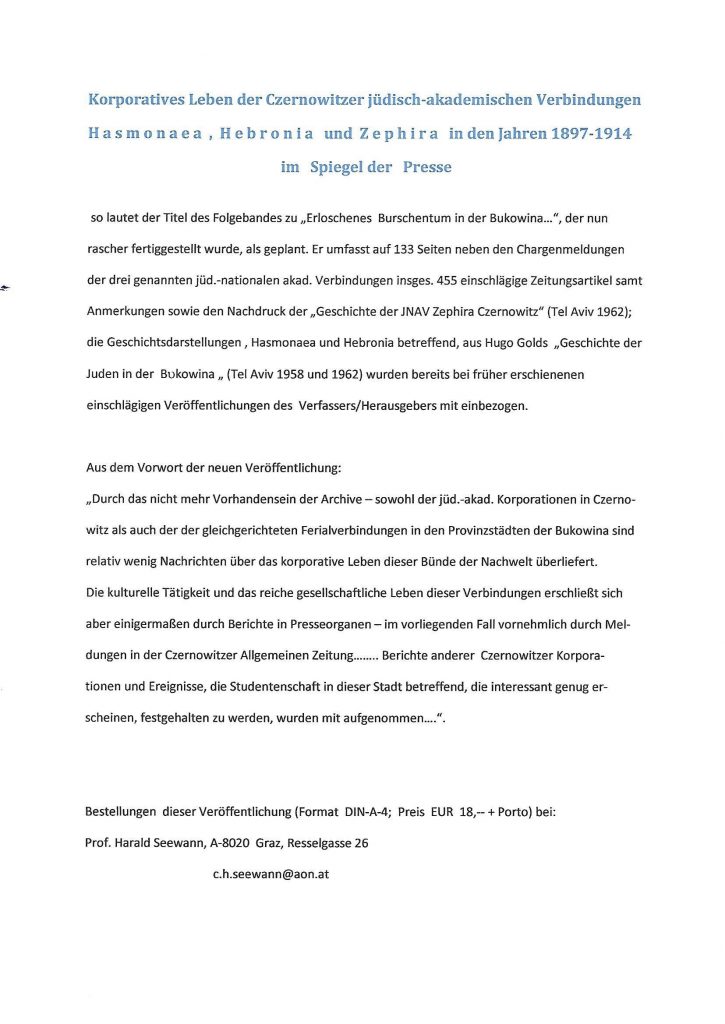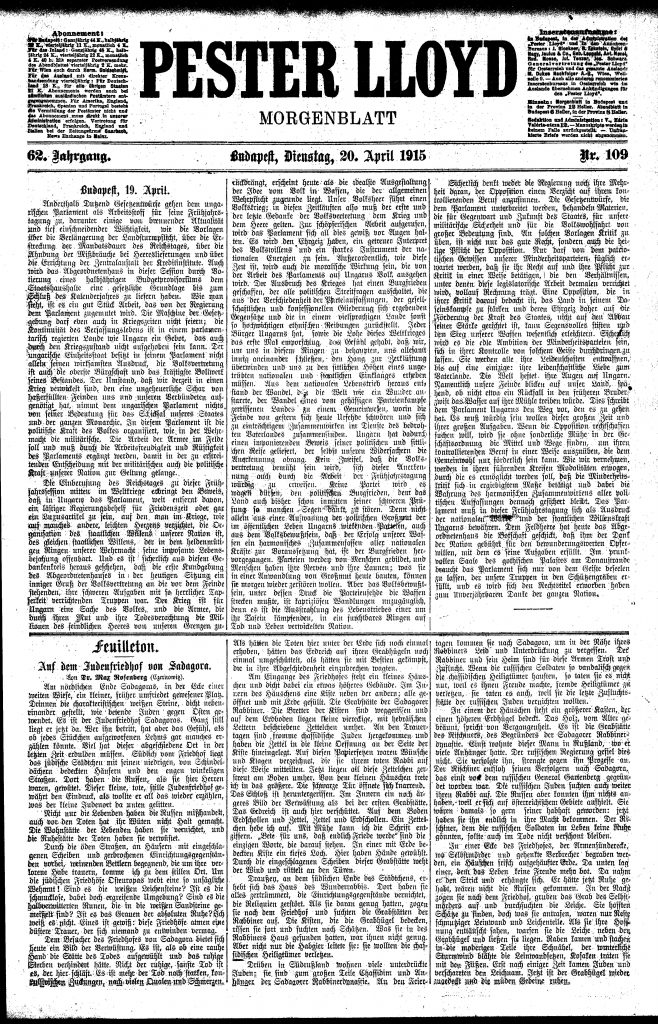Read more:
http://czernowitzbook.blogspot.de/2015/12/fur-volkes-ehr-und-wohl-for-peoples.html
Bearing Witness: Paula Neuman Gris
Bearing Witness: Paula Neuman Gris from The Breman Museum on Vimeo.
Remarkable Stories from the Holocaust
With her mother performing backbreaking labor for the Nazis in the rock quarries of Transnistria, Paula Neuman Gris was the sole caretaker of her baby sister. Barely older than a toddler herself, Paula had to use her own smarts and spirited nature to survive. Experience Paula’s incredible story of determination at the Breman’s Bearing Witness, Jan. 17, 2016.
Hardy Breier’s…
My Czernowitz
TARANTELA ABUCURESTEANA
Emunah Czernowitz – “Heimkehr” Essays jüdischer Denker
Another of the Jewish fraternities was “Emunah”. On June 3, 1903, the Jewish National Academic Reading Society was “thrown open,” with the club colors gold-violet-gold. “Emunah” was highly active in the field of Zionism – a characteristic for all the Jewish fraternities – and also set up a library open to the public. Furthermore, “Emunahs” intellectual athmosphere culminated in publishing several books. To mention is especially “Heimkehr. Essays jüdischer Denker” with a preface by Leon Kellner. (Homecoming. Essays of Jewish Thinkers). This anthology contains contributions by notable Jewish authors like Balaban Majer, Nathan Birnbaum (who coined the term “Zionism”), Max Rosenfeld, Salomon Schiller and Leon Kellner. It came out 1912 and is now available online via the university library of Frankfurt: http://sammlungen.ub.uni-frankfurt.de/freimann/content/titleinfo/936863

JNAV Heatid Czernowitz
Hi all, i am currently worlking on a Research paper on Czernowitz Jewish academic fraternities. With “Hasmonäa”, founded 1891 by members of the Viennese “Kadimah”, this new type of Jewish academic fraternity appeared in Czernowitz and found successors throughout the German-speaking Universities. The Jewish academic fraternities were modeled after the traditional type of “Studentenverbindung”, that existed in Czernowitz from 1875-1938/40. The members of the various “frats” distinguished themselves by wearing ribbons and caps showing the club colors of their fraternity. In the Romanian period the University organisation was changed to the “college System” and members of the fraternities were issued membership cards. here i have got one issued by JNAV “Heatid” for Josef Stark in 1922. “Heatid” came into being in 1918/19 and existed until 1936. Its club colors used to be green-silver-black shown in the ribbons with white caps. Any further information on “Heatid”, Josef Stark or any of the Czernowitz fraternities – especially photographs – would be highly appreciated. Thank You!
At the Jewish Cemetery of Sadagora
![]()
“Bukovina is in every sense a paradox. Everything is upside down here. It almost seems as if this topsy-turvy element had to belong to the nature of this land, as if its character was to consist of this. Everyone feels that Bukovina is something special, not to be put on a level with the other crownlands and that its cultural ties also have a certain nuance of their own, something different from the ordinary. Yet, they only feel. What this character is, however, very few have so far attempted to fathom.”
This is a citation of Dr. Max Rosenberg from Czernowitz from the year 1914, preposed by H. F. van Drunen to his thesis “‘A Sanguine Bunch’ – Regional Identification in Habsburg Bukovina, 1774-1919” (Book of the Month, January 2015):
http://czernowitzbook.blogspot.de/2015/01/a-sanguine-bunch.html
One year later, in 1915, under the impression of the devastations caused during the Russian occupation, Dr. Max Rosenberg is visiting the Jewish Cemetery of Sadagora and his impressive report – see above – was published by the prestigious “Pester Lloyd” from Budapest on April 20, 1915:
Auf dem Judenfriedhof von Sadagora. Von Dr. Max Rosenberg (Czernowitz).
Am nördlichen Ende Sadagoras, in der Ecke einer weiten Wiese, ein kleiner, früher umfriedet gewesener Platz. Drinnen die charakteristischen weißen Steine, dicht nebeneinander gestellt, wie betende Juden gegen Osten gewendet. Es ist der Judenfriedhof Sadagoras. Ganz still liegt er jetzt da. Wer ihn betritt, hat aber das Gefühl, als ob jedes Stückchen aufgeworfenen Lehms gar manches erzählen könnte. Viel hat dieser abgeschiedene Ort in der letzten Zeit erdulden müssen. Südlich vom Friedhof liegt das jüdische Städtchen mit seinen niedrigen, von Schindeldächern bedeckten Häusern und den engen winkeligen Straßen. Dort haben die Russen, als sie hier Herren waren, gewütet. Dieser kleine, tote, stille Judenfriedhof gewährt den Eindruck, als wollte er all das wieder erzählen, was der kleine Judenort da unten gelitten.
Death Certificates Issued by the Czernowitz Jewish Hospital for the Year 1915
Excerpt from the article “On the history of the Jews in Czernowitz” by Prof. Dr. Herman Sternberg: “During the war years, Czernowitz could hardly be recognized. People frightened and weighed down with troubles, hurried like shadows through the streets. Military uniforms dominated the cityscape. Officers and tired soldiers were on their way to or from the railroad station. The station building, heated in winter had become a dormitory. Soldiers slept on the floor pressed closely together, leaving no space free. Anyone seeking the entrance had to step over them. The closer the war came to its end, the greater became the lack of food and other necessities. The most difficult articles to obtain were fuel and foot wear. Prices rose from day to day. The greatly reduced Jewish population suffered indescribable difficulties. Intellectual life had died completely. After the fall of darkness, all traffic ceased because the street lights didn’t work. Families generally restricted themselves to one room, dimly lit with an oil lamp. The only topic of conversation was the war and its consequences.”
Courtesy: Jewish Genealogical Society Of Ottawa
JDC List of Surviving Jews in U.S.S.R. (Poland)
Courtesy: JDC Archives
Source: Folder Camps and Locations, USSR, 1945
Download: List of Surviving Jews in U.S.S.R. (Poland)
Opening of the Kosher Organic Restaurant in Chernivtsi
Lehmann Online

One of the major digitization projects for the Vienna City Library, located on the 1st floor of the Vienna City Hall since the building’s completion in 1883, covers Lehmann’s Address Books for Vienna between 1859-1942. Once the project has been completed in 2011, about 200,000 pages became available for researchers. Keeping in mind that many Czernowitzers escaped to Vienna during WW1, this online database is an important resource both for genealogists and historians focussed on Bukovina. Click on the logo below in order to research the annual volumes between 1859-1942!
You don’t need to read German for your research. Look (1.) for the period of time. Scroll down (2.) to the requested year. Check (3.) the volume(s) displayed for the subsection “Namenverzeichnis” [catalogue of names] and refine your search accordingly. Enjoy (4.) the results of your research!








